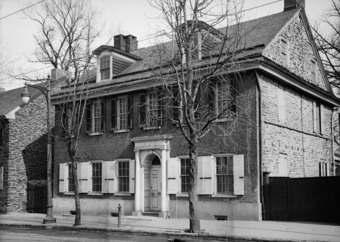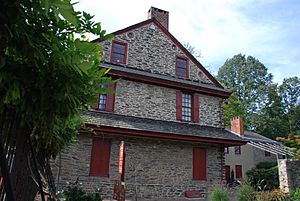Grumblethorpe facts for kids
Quick facts for kids |
|
|
Grumblethorpe
|
|
|
U.S. National Historic Landmark District
Contributing Property |
|

Grumblethorpe prior to its restoration in the 1960s, displaying its early 19th-century Georgian-style façade
|
|
| Location | 5267 Germantown Avenue, Germantown, Philadelphia, Pennsylvania, U.S. |
|---|---|
| Area | < 1-acre (4,000 m2) |
| Built | 1744 |
| Architectural style | American Georgian |
| NRHP reference No. | 72001155 |
| Added to NRHP | March 16, 1972 |
Grumblethorpe is a historic house in Germantown, a part of Philadelphia, Pennsylvania. It was the home of the Wister family for over 160 years. Built in 1744, it started as a summer house. Later, in 1793, it became their full-time home. Today, Grumblethorpe is a museum. It is also part of the Colonial Germantown Historic District, a special area with many old buildings.
Contents
What is Grumblethorpe?
Building a Home in the 1700s
Grumblethorpe was built in 1744 by John Wister. He was a merchant from Philadelphia who imported wine. At that time, Germantown was a quiet, country area outside of Philadelphia. The Wister family first used Grumblethorpe as a summer house.
In 1793, a serious illness spread through Philadelphia. The Wister family decided to move out of the city. Grumblethorpe then became their home all year round.
The house is made of stone and oak. It was known as "John Wister's Big House." The stones came from the land around the house. The wooden beams were cut from oak trees in Wister Woods, which the family also owned.
The Wister family lived in this house for more than 160 years. Sally Wister, who wrote a famous diary, lived there from 1789 until she passed away in 1804.
A Working Farm and Garden
Grumblethorpe was built on very good soil. This made its garden very productive. For almost 200 years, from 1740 to 1910, Grumblethorpe was a very important farm. It helped shape how people gardened in Philadelphia.
The land was used to grow crops and raise animals. This was a main source of income for the family from the 1740s to the 1870s. The farm became smaller later in the 1800s, so it was used less for farming.
Grumblethorpe During the American Revolutionary War
In September 1777, Grumblethorpe was part of the Battle of Germantown. The Wister family was staying somewhere else during this time. A British General named James Agnew used the house as his headquarters.
During the battle, General Agnew was hurt. He passed away in the front room of the house. You can still see bloodstains on the floor from that event.
Grumblethorpe as a Museum Today
In the 1960s, Grumblethorpe was carefully restored. It was made to look like it did when it was first built. An older style front from the 1800s was removed. Now, the house is a museum. The gardens are also being restored to their original look.
Grumblethorpe was added to the National Register of Historic Places in 1972. This means it is a very important historic site. It is also a key part of the Colonial Germantown Historic District. This district is recognized as a National Historic Landmark.
See also






